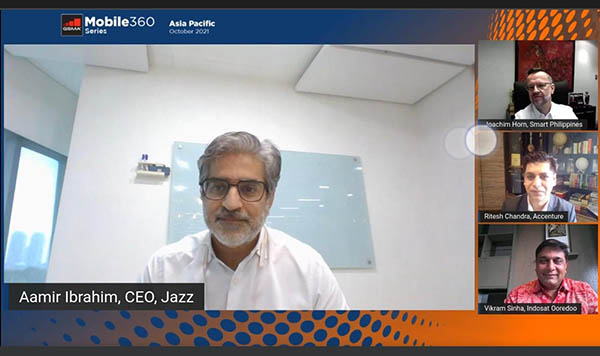
Screengrab of the 5G panel
Countries with commercially available 5G have achieved 70% or more 4G penetration, while Pakistan currently stands at 43%. We need a 4G-for-all approach; not 5G for few
Prior to adopting 5G wireless technology, policymakers in Pakistan must sit with stakeholders and devise plans for the country’s digital ecosystem that support the shift from prevailing 3G and 4G services, Jazz CEO Aamir Ibrahim said during a panel discussion last week.
“There is a lot of hype about 5G amongst business leaders, policymakers, and the media, but this is not the same revolution of two decades ago when 3G was the big deal and countries jumped on the bandwagon without a clear roadmap,” he stressed during an Expectations, Experiences and Reality of 5G Journey panel organized by the GSMA’s Mobile360 Asia-Pacific conference. “The times have changed, now the world is a whole lot smarter and telecom investors are more astute. Policymakers first need to sit with a range of stakeholders to work upon the digital ecosystem including the use cases to support the adoption of technology,” he added.
These prerequisite steps, maintained Ibrahim, were essential for attracting operators to 5G. “5G requires fundamental changes in both investment strategy, spectrum policy and deployment,” he told panel moderator Ritesh Chandra, the managing director of Accenture. “It also requires much higher upfront investment costs, principally capex [capital expenditure], and yet faces higher uncertainty in commercialization of the novel use cases. Adopting and implementing a 5G network requires a concerted effort from all stakeholders to overhaul outdated policies, ensure availability of affordable smart devices, strike partnerships, garner investments, release spectrum, develop digital skills, create demand, and foster innovation,” he added.
The Jazz CEO said he believed Pakistan’s infrastructure needed to be further developed before it could adopt and implement 5G. “For consumers, if their demand is merely faster speeds, we can provide that through a more robust 4G infrastructure,” he explained.
Ibrahim was joined on the 5G panel by Indonesia’s Vikram Sinha, the chief operating officer of Indosat Ooredoo, and Joachim Horn, the chief technology and information adviser for Smart Communications of the Philippines. Both industry leaders agreed with his take on the utility of 5G, stressing that consumer demand should be matched by policymaking.
“It needs to be more than just a speed game,” said Indosat’s Sinha, whose company introduced 5G services to various Indonesian cities, including Jakarta, this year. “We are now clear that the consumer’s demand for low-latency services will only be possible if the policies support it. We are also working on some exciting enterprise/business cases but for these to be commercially viable it is important for all stakeholders to collaborate,” he said. “The 5G journey has to be much more meaningful than the need to create big noise,” he added.
Offering insight into the launch of 5G services in the Philippines, Smart Communications’ Horn added: “We decided to launch 5G when smartphone prices fell to around $150. But on the enterprise side, the situation was completely different. The interest is high but the knowledge is limited, so it takes a lot of education to make businesses understand the opportunity. The road is long and we need to help enterprises integrate 5G into the ecosystem and eventually develop the use case.”
Jazz’s Ibrahim noted that rather than prioritizing new services for existing users of mobile internet, the focus should be on expanding their numbers. “45 percent of subscribers don’t use mobile broadband, while 15 percent of the population lives without any telecom coverage,” he said of Pakistan. “Countries that have commercially launched 5G have achieved close to 70 percent or more 4G penetration, while this number stands at around 43 percent in Pakistan. We need a 4G-for-all approach now, rather than 5G for few,” he added.
Nevertheless, he said, Jazz was observing the launch of 5G services globally and noting the type of impact it could have on telecommunications. “We are keenly exploring global 5G case studies and connecting with colleagues from various countries to understand the type of impact 5G has had,” he said. “We are not oblivious to the advantages, but at the same time we understand that landscapes and policies differ significantly from one country to another. For example, Japan and China have allocated free 5G spectrum and South Korea offers tax breaks to operators to compensate for rollout costs. The decision on when to launch 5G is based on triggers that are localized for each market, given the different stages of 5G readiness. We already tested 5G services back in January 2020, but the race to new technology is not currently feasible,” he added.
